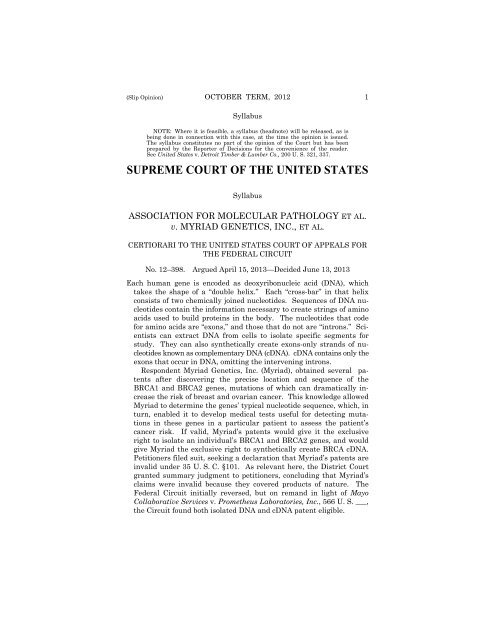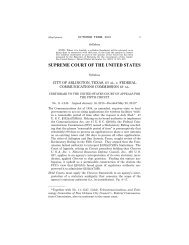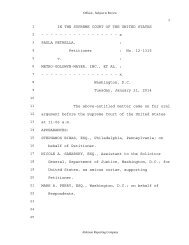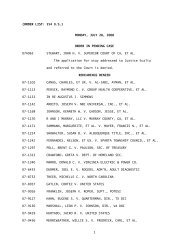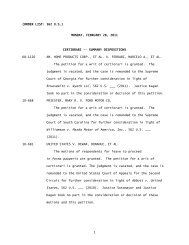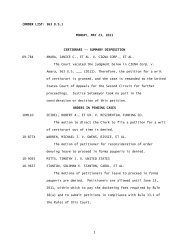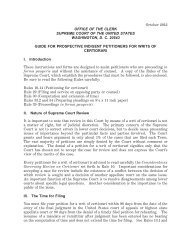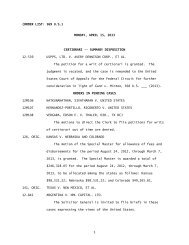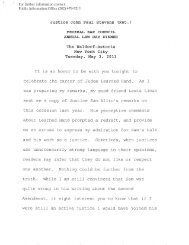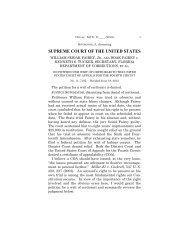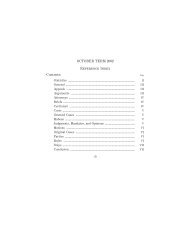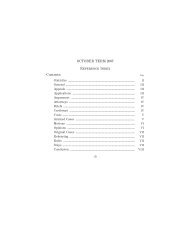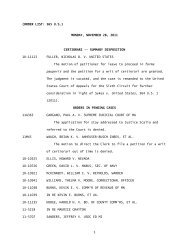12-398 Association for Molecular Pathology v. Myriad Genetics, Inc ...
12-398 Association for Molecular Pathology v. Myriad Genetics, Inc ...
12-398 Association for Molecular Pathology v. Myriad Genetics, Inc ...
Create successful ePaper yourself
Turn your PDF publications into a flip-book with our unique Google optimized e-Paper software.
(Slip Opinion) OCTOBER TERM, 20<strong>12</strong><br />
Syllabus<br />
NOTE: Where it is feasible, a syllabus (headnote) will be released, as is<br />
being done in connection with this case, at the time the opinion is issued.<br />
The syllabus constitutes no part of the opinion of the Court but has been<br />
prepared by the Reporter of Decisions <strong>for</strong> the convenience of the reader.<br />
See United States v. Detroit Timber & Lumber Co., 200 U. S. 321, 337.<br />
SUPREME COURT OF THE UNITED STATES<br />
Syllabus<br />
ASSOCIATION FOR MOLECULAR PATHOLOGY ET AL.<br />
v. MYRIAD GENETICS, INC., ET AL.<br />
CERTIORARI TO THE UNITED STATES COURT OF APPEALS FOR<br />
THE FEDERAL CIRCUIT<br />
No. <strong>12</strong>–<strong>398</strong>. Argued April 15, 2013—Decided June 13, 2013<br />
Each human gene is encoded as deoxyribonucleic acid (DNA), which<br />
takes the shape of a “double helix.” Each “cross-bar” in that helix<br />
consists of two chemically joined nucleotides. Sequences of DNA nucleotides<br />
contain the in<strong>for</strong>mation necessary to create strings of amino<br />
acids used to build proteins in the body. The nucleotides that code<br />
<strong>for</strong> amino acids are “exons,” and those that do not are “introns.” Scientists<br />
can extract DNA from cells to isolate specific segments <strong>for</strong><br />
study. They can also synthetically create exons-only strands of nucleotides<br />
known as complementary DNA (cDNA). cDNA contains only the<br />
exons that occur in DNA, omitting the intervening introns.<br />
Respondent <strong>Myriad</strong> <strong>Genetics</strong>, <strong>Inc</strong>. (<strong>Myriad</strong>), obtained several patents<br />
after discovering the precise location and sequence of the<br />
BRCA1 and BRCA2 genes, mutations of which can dramatically increase<br />
the risk of breast and ovarian cancer. This knowledge allowed<br />
<strong>Myriad</strong> to determine the genes’ typical nucleotide sequence, which, in<br />
turn, enabled it to develop medical tests useful <strong>for</strong> detecting mutations<br />
in these genes in a particular patient to assess the patient’s<br />
cancer risk. If valid, <strong>Myriad</strong>’s patents would give it the exclusive<br />
right to isolate an individual’s BRCA1 and BRCA2 genes, and would<br />
give <strong>Myriad</strong> the exclusive right to synthetically create BRCA cDNA.<br />
Petitioners filed suit, seeking a declaration that <strong>Myriad</strong>’s patents are<br />
invalid under 35 U. S. C. §101. As relevant here, the District Court<br />
granted summary judgment to petitioners, concluding that <strong>Myriad</strong>’s<br />
claims were invalid because they covered products of nature. The<br />
Federal Circuit initially reversed, but on remand in light of Mayo<br />
Collaborative Services v. Prometheus Laboratories, <strong>Inc</strong>., 566 U. S. ___,<br />
the Circuit found both isolated DNA and cDNA patent eligible.<br />
1
2 ASSOCIATION FOR MOLECULAR PATHOLOGY v.<br />
MYRIAD GENETICS, INC.<br />
Syllabus<br />
Held: A naturally occurring DNA segment is a product of nature and<br />
not patent eligible merely because it has been isolated, but cDNA is<br />
patent eligible because it is not naturally occurring. Pp. 10–18.<br />
(a) The Patent Act permits patents to be issued to “[w]hoever invents<br />
or discovers any new and useful . . . composition of matter,”<br />
§101, but “laws of nature, natural phenomena, and abstract ideas”<br />
“ ‘are basic tools of scientific and technological work’ ” that lie beyond<br />
the domain of patent protection, Mayo, supra, at ___. The rule<br />
against patents on naturally occurring things has limits, however.<br />
Patent protection strikes a delicate balance between creating “incentives<br />
that lead to creation, invention, and discovery” and “imped[ing]<br />
the flow of in<strong>for</strong>mation that might permit, indeed spur, invention.”<br />
Id., at ___. This standard is used to determine whether <strong>Myriad</strong>’s patents<br />
claim a “new and useful . . . composition of matter,” §101, or<br />
claim naturally occurring phenomena. Pp. 10–11.<br />
(b) <strong>Myriad</strong>’s DNA claim falls within the law of nature exception.<br />
<strong>Myriad</strong>’s principal contribution was uncovering the precise location<br />
and genetic sequence of the BRCA1 and BRCA2 genes. Diamond v.<br />
Chakrabarty, 447 U. S. 303, is central to the patent-eligibility inquiry<br />
whether such action was new “with markedly different characteristics<br />
from any found in nature,” id., at 310. <strong>Myriad</strong> did not create or<br />
alter either the genetic in<strong>for</strong>mation encoded in the BCRA1 and<br />
BCRA2 genes or the genetic structure of the DNA. It found an important<br />
and useful gene, but groundbreaking, innovative, or even<br />
brilliant discovery does not by itself satisfy the §101 inquiry. See<br />
Funk Brothers Seed Co. v. Kalo Inoculant Co., 333 U. S. <strong>12</strong>7. Finding<br />
the location of the BRCA1 and BRCA2 genes does not render the<br />
genes patent eligible “new . . . composition[s] of matter,” §101. <strong>Myriad</strong>’s<br />
patent descriptions highlight the problem with its claims: They<br />
detail the extensive process of discovery, but extensive ef<strong>for</strong>t alone is<br />
insufficient to satisfy §101’s demands. <strong>Myriad</strong>’s claims are not saved<br />
by the fact that isolating DNA from the human genome severs the<br />
chemical bonds that bind gene molecules together. The claims are<br />
not expressed in terms of chemical composition, nor do they rely on<br />
the chemical changes resulting from the isolation of a particular DNA<br />
section. Instead, they focus on the genetic in<strong>for</strong>mation encoded in the<br />
BRCA1 and BRCA2 genes. Finally, <strong>Myriad</strong> argues that the Patent<br />
and Trademark Office’s past practice of awarding gene patents is entitled<br />
to deference, citing J. E. M. Ag Supply, <strong>Inc</strong>. v. Pioneer Hi-Bred<br />
Int’l, <strong>Inc</strong>., 534 U. S. <strong>12</strong>4, a case where Congress had endorsed a PTO<br />
practice in subsequent legislation. There has been no such endorsement<br />
here, and the United States argued in the Federal Circuit and<br />
in this Court that isolated DNA was not patent eligible under §101.<br />
Pp. <strong>12</strong>–16.
Cite as: 569 U. S. ____ (2013)<br />
Syllabus<br />
(c) cDNA is not a “product of nature,” so it is patent eligible under<br />
§101. cDNA does not present the same obstacles to patentability as<br />
naturally occurring, isolated DNA segments. Its creation results in<br />
an exons-only molecule, which is not naturally occurring. Its order of<br />
the exons may be dictated by nature, but the lab technician unquestionably<br />
creates something new when introns are removed from a<br />
DNA sequence to make cDNA. Pp. 16–17.<br />
(d) This case, it is important to note, does not involve method<br />
claims, patents on new applications of knowledge about the BRCA1<br />
and BRCA2 genes, or the patentability of DNA in which the order of<br />
the naturally occurring nucleotides has been altered. Pp. 17–18.<br />
689 F. 3d 1303, affirmed in part and reversed in part.<br />
THOMAS, J., delivered the opinion of the Court, in which ROBERTS,<br />
C. J., and KENNEDY, GINSBURG, BREYER, ALITO, SOTOMAYOR, and KAGAN,<br />
JJ., joined, and in which SCALIA, J., joined in part. SCALIA, J., filed an<br />
opinion concurring in part and concurring in the judgment.<br />
3
Cite as: 569 U. S. ____ (2013)<br />
Opinion of the Court<br />
NOTICE: This opinion is subject to <strong>for</strong>mal revision be<strong>for</strong>e publication in the<br />
preliminary print of the United States Reports. Readers are requested to<br />
notify the Reporter of Decisions, Supreme Court of the United States, Washington,<br />
D. C. 20543, of any typographical or other <strong>for</strong>mal errors, in order<br />
that corrections may be made be<strong>for</strong>e the preliminary print goes to press.<br />
SUPREME COURT OF THE UNITED STATES<br />
_________________<br />
No. <strong>12</strong>–<strong>398</strong><br />
_________________<br />
ASSOCIATION FOR MOLECULAR PATHOLOGY,<br />
ET AL., PETITIONERS v. MYRIAD<br />
GENETICS, INC., ET AL.<br />
ON WRIT OF CERTIORARI TO THE UNITED STATES COURT OF<br />
APPEALS FOR THE FEDERAL CIRCUIT<br />
[June 13, 2013]<br />
JUSTICE THOMAS delivered the opinion of the Court.<br />
Respondent <strong>Myriad</strong> <strong>Genetics</strong>, <strong>Inc</strong>. (<strong>Myriad</strong>), discovered<br />
the precise location and sequence of two human genes,<br />
mutations of which can substantially increase the risks of<br />
breast and ovarian cancer. <strong>Myriad</strong> obtained a number<br />
of patents based upon its discovery. This case involves<br />
claims from three of them and requires us to resolve<br />
whether a naturally occurring segment of deoxyribonucleic<br />
acid (DNA) is patent eligible under 35 U. S. C. §101 by<br />
virtue of its isolation from the rest of the human genome.<br />
We also address the patent eligibility of synthetically<br />
created DNA known as complementary DNA (cDNA), which<br />
contains the same protein-coding in<strong>for</strong>mation found in<br />
a segment of natural DNA but omits portions within the<br />
DNA segment that do not code <strong>for</strong> proteins. For the reasons<br />
that follow, we hold that a naturally occurring DNA<br />
segment is a product of nature and not patent eligible<br />
merely because it has been isolated, but that cDNA is<br />
patent eligible because it is not naturally occurring. We,<br />
there<strong>for</strong>e, affirm in part and reverse in part the decision of<br />
1
2 ASSOCIATION FOR MOLECULAR PATHOLOGY v.<br />
MYRIAD GENETICS, INC.<br />
Opinion of the Court<br />
the United States Court of Appeals <strong>for</strong> the Federal Circuit.<br />
I<br />
A<br />
Genes <strong>for</strong>m the basis <strong>for</strong> hereditary traits in living<br />
organisms. See generally <strong>Association</strong> <strong>for</strong> <strong>Molecular</strong> <strong>Pathology</strong><br />
v. United States Patent and Trademark Office, 702<br />
F. Supp. 2d 181, 192–211 (SDNY 2010). The human genome<br />
consists of approximately 22,000 genes packed into<br />
23 pairs of chromosomes. Each gene is encoded as DNA,<br />
which takes the shape of the familiar “double helix”<br />
that Doctors James Watson and Francis Crick first described<br />
in 1953. Each “cross-bar” in the DNA helix consists<br />
of two chemically joined nucleotides. The possible<br />
nucleotides are adenine (A), thymine (T), cytosine (C), and<br />
guanine (G), each of which binds naturally with another<br />
nucleotide: A pairs with T; C pairs with G. The nucleotide<br />
cross-bars are chemically connected to a sugar-phosphate<br />
backbone that <strong>for</strong>ms the outside framework of the DNA<br />
helix. Sequences of DNA nucleotides contain the in<strong>for</strong>mation<br />
necessary to create strings of amino acids, which<br />
in turn are used in the body to build proteins. Only some<br />
DNA nucleotides, however, code <strong>for</strong> amino acids; these<br />
nucleotides are known as “exons.” Nucleotides that do not<br />
code <strong>for</strong> amino acids, in contrast, are known as “introns.”<br />
Creation of proteins from DNA involves two principal<br />
steps, known as transcription and translation. In transcription,<br />
the bonds between DNA nucleotides separate,<br />
and the DNA helix unwinds into two single strands. A<br />
single strand is used as a template to create a complementary<br />
ribonucleic acid (RNA) strand. The nucleotides on the<br />
DNA strand pair naturally with their counterparts, with<br />
the exception that RNA uses the nucleotide base uracil (U)<br />
instead of thymine (T). Transcription results in a single<br />
strand RNA molecule, known as pre-RNA, whose nucleotides<br />
<strong>for</strong>m an inverse image of the DNA strand from which
Cite as: 569 U. S. ____ (2013)<br />
Opinion of the Court<br />
it was created. Pre-RNA still contains nucleotides corresponding<br />
to both the exons and introns in the DNA molecule.<br />
The pre-RNA is then naturally “spliced” by the<br />
physical removal of the introns. The resulting product is a<br />
strand of RNA that contains nucleotides corresponding<br />
only to the exons from the original DNA strand. The<br />
exons-only strand is known as messenger RNA (mRNA),<br />
which creates amino acids through translation. In translation,<br />
cellular structures known as ribosomes read each<br />
set of three nucleotides, known as codons, in the mRNA.<br />
Each codon either tells the ribosomes which of the 20<br />
possible amino acids to synthesize or provides a stop<br />
signal that ends amino acid production.<br />
DNA’s in<strong>for</strong>mational sequences and the processes that<br />
create mRNA, amino acids, and proteins occur naturally<br />
within cells. Scientists can, however, extract DNA from<br />
cells using well known laboratory methods. These methods<br />
allow scientists to isolate specific segments of DNA—<br />
<strong>for</strong> instance, a particular gene or part of a gene—which<br />
can then be further studied, manipulated, or used. It is also<br />
possible to create DNA synthetically through processes<br />
similarly well known in the field of genetics. One such<br />
method begins with an mRNA molecule and uses the<br />
natural bonding properties of nucleotides to create a new,<br />
synthetic DNA molecule. The result is the inverse of the<br />
mRNA’s inverse image of the original DNA, with one<br />
important distinction: Because the natural creation of<br />
mRNA involves splicing that removes introns, the synthetic<br />
DNA created from mRNA also contains only the exon<br />
sequences. This synthetic DNA created in the laboratory<br />
from mRNA is known as complementary DNA (cDNA).<br />
Changes in the genetic sequence are called mutations.<br />
Mutations can be as small as the alteration of a single<br />
nucleotide—a change affecting only one letter in the genetic<br />
code. Such small-scale changes can produce an entirely<br />
different amino acid or can end protein production alto-<br />
3
4 ASSOCIATION FOR MOLECULAR PATHOLOGY v.<br />
MYRIAD GENETICS, INC.<br />
Opinion of the Court<br />
gether. Large changes, involving the deletion, rearrangement,<br />
or duplication of hundreds or even millions of nucleotides,<br />
can result in the elimination, misplacement, or<br />
duplication of entire genes. Some mutations are harmless,<br />
but others can cause disease or increase the risk of disease.<br />
As a result, the study of genetics can lead to valu-<br />
able medical breakthroughs.<br />
B<br />
This case involves patents filed by <strong>Myriad</strong> after it made<br />
one such medical breakthrough. <strong>Myriad</strong> discovered the<br />
precise location and sequence of what are now known as<br />
the BRCA1 and BRCA2 genes. Mutations in these genes<br />
can dramatically increase an individual’s risk of developing<br />
breast and ovarian cancer. The average American<br />
woman has a <strong>12</strong>- to 13-percent risk of developing breast<br />
cancer, but <strong>for</strong> women with certain genetic mutations, the<br />
risk can range between 50 and 80 percent <strong>for</strong> breast cancer<br />
and between 20 and 50 percent <strong>for</strong> ovarian cancer.<br />
Be<strong>for</strong>e <strong>Myriad</strong>’s discovery of the BRCA1 and BRCA2<br />
genes, scientists knew that heredity played a role in establishing<br />
a woman’s risk of developing breast and ovarian<br />
cancer, but they did not know which genes were associated<br />
with those cancers.<br />
<strong>Myriad</strong> identified the exact location of the BRCA1 and<br />
BRCA2 genes on chromosomes 17 and 13. Chromosome<br />
17 has approximately 80 million nucleotides, and chromosome<br />
13 has approximately 114 million. <strong>Association</strong><br />
<strong>for</strong> <strong>Molecular</strong> <strong>Pathology</strong> v. United States Patent and Trademark<br />
Office, 689 F. 3d 1303, 1328 (CA Fed. 20<strong>12</strong>). Within<br />
those chromosomes, the BRCA1 and BRCA2 genes are<br />
each about 80,000 nucleotides long. If just exons are<br />
counted, the BRCA1 gene is only about 5,500 nucleotides<br />
long; <strong>for</strong> the BRCA2 gene, that number is about 10,200.<br />
Ibid. Knowledge of the location of the BRCA1 and BRCA2<br />
genes allowed <strong>Myriad</strong> to determine their typical nucleotide
Cite as: 569 U. S. ____ (2013)<br />
Opinion of the Court<br />
sequence. 1 That in<strong>for</strong>mation, in turn, enabled <strong>Myriad</strong> to<br />
develop medical tests that are useful <strong>for</strong> detecting mutations<br />
in a patient’s BRCA1 and BRCA2 genes and thereby<br />
assessing whether the patient has an increased risk of<br />
cancer.<br />
Once it found the location and sequence of the BRCA1<br />
and BRCA2 genes, <strong>Myriad</strong> sought and obtained a number<br />
of patents. Nine composition claims from three of those<br />
patents are at issue in this case. 2 See id., at 1309, and<br />
n. 1 (noting composition claims). Claims 1, 2, 5, and 6<br />
from the ’282 patent are representative. The first claim<br />
asserts a patent on “[a]n isolated DNA coding <strong>for</strong> a BRCA1<br />
polypeptide,” which has “the amino acid sequence set <strong>for</strong>th<br />
in SEQ ID NO:2.” App. 822. SEQ ID NO:2 sets <strong>for</strong>th a list<br />
of 1,863 amino acids that the typical BRCA1 gene encodes.<br />
See id., at 785–790. Put differently, claim 1 asserts a<br />
patent claim on the DNA code that tells a cell to produce<br />
the string of BRCA1 amino acids listed in SEQ ID NO:2.<br />
Claim 2 of the ’282 patent operates similarly. It claims<br />
“[t]he isolated DNA of claim 1, wherein said DNA has the<br />
nucleotide sequence set <strong>for</strong>th in SEQ ID NO:1.” Id., at<br />
822. Like SEQ ID NO:2, SEQ ID NO:1 sets <strong>for</strong>th a<br />
long list of data, in this instance the sequence of cDNA that<br />
codes <strong>for</strong> the BRCA1 amino acids listed in claim 1. Importantly,<br />
SEQ ID NO:1 lists only the cDNA exons in the<br />
BRCA1 gene, rather than a full DNA sequence containing<br />
both exons and introns. See id., at 779 (stating that<br />
SEQ ID NO:1’s “MOLECULE TYPE:” is “cDNA”). As a result,<br />
the Federal Circuit recognized that claim 2 asserts a<br />
patent on the cDNA nucleotide sequence listed in SEQ ID<br />
——————<br />
1 Technically, there is no “typical” gene because nucleotide sequences<br />
vary between individuals, sometimes dramatically. Geneticists refer to<br />
the most common variations of genes as “wild types.”<br />
2 At issue are claims 1, 2, 5, 6, and 7 of U. S. Patent 5,747,282 (the<br />
’282 patent), claim 1 of U. S. Patent 5,693,473 (the ’473 patent), and<br />
claims 1, 6, and 7 of U. S. Patent 5,837,492 (the ’492 patent).<br />
5
6 ASSOCIATION FOR MOLECULAR PATHOLOGY v.<br />
MYRIAD GENETICS, INC.<br />
Opinion of the Court<br />
NO:1, which codes <strong>for</strong> the typical BRCA1 gene. 689 F. 3d,<br />
at 1326, n. 9; id., at 1337 (Moore, J., concurring in part);<br />
id., at 1356 (Bryson, J., concurring in part and dissenting<br />
in part).<br />
Claim 5 of the ’282 patent claims a subset of the data in<br />
claim 1. In particular, it claims “[a]n isolated DNA having<br />
at least 15 nucleotides of the DNA of claim 1.” App. 822.<br />
The practical effect of claim 5 is to assert a patent on any<br />
series of 15 nucleotides that exist in the typical BRCA1<br />
gene. Because the BRCA1 gene is thousands of nucleotides<br />
long, even BRCA1 genes with substantial mutations<br />
are likely to contain at least one segment of 15 nucleotides<br />
that correspond to the typical BRCA1 gene. Similarly,<br />
claim 6 of the ’282 patent claims “[a]n isolated DNA having<br />
at least 15 nucleotides of the DNA of claim 2.” Ibid.<br />
This claim operates similarly to claim 5, except that it<br />
references the cDNA-based claim 2. The remaining claims<br />
at issue are similar, though several list common mutations<br />
rather than typical BRCA1 and BRCA2 sequences. See<br />
ibid. (claim 7 of the ’282 patent); id., at 930 (claim 1 of the<br />
’473 patent); id., at 1028 (claims 1, 6, and 7 of the ’492<br />
patent).<br />
C<br />
<strong>Myriad</strong>’s patents would, if valid, give it the exclusive<br />
right to isolate an individual’s BRCA1 and BRCA2 genes<br />
(or any strand of 15 or more nucleotides within the genes)<br />
by breaking the covalent bonds that connect the DNA to<br />
the rest of the individual’s genome. The patents would<br />
also give <strong>Myriad</strong> the exclusive right to synthetically create<br />
BRCA cDNA. In <strong>Myriad</strong>’s view, manipulating BRCA DNA<br />
in either of these fashions triggers its “right to exclude<br />
others from making” its patented composition of matter<br />
under the Patent Act. 35 U. S. C. §154(a)(1); see also<br />
§271(a) (“[W]hoever without authority makes . . . any<br />
patented invention . . . infringes the patent”).
Cite as: 569 U. S. ____ (2013)<br />
Opinion of the Court<br />
But isolation is necessary to conduct genetic testing, and<br />
<strong>Myriad</strong> was not the only entity to offer BRCA testing after<br />
it discovered the genes. The University of Pennsylvania’s<br />
Genetic Diagnostic Laboratory (GDL) and others provided<br />
genetic testing services to women. Petitioner Dr. Harry<br />
Ostrer, then a researcher at New York University School<br />
of Medicine, routinely sent his patients’ DNA samples to<br />
GDL <strong>for</strong> testing. After learning of GDL’s testing and<br />
Ostrer’s activities, <strong>Myriad</strong> sent letters to them asserting<br />
that the genetic testing infringed <strong>Myriad</strong>’s patents. App.<br />
94–95 (Ostrer letter). In response, GDL agreed to stop<br />
testing and in<strong>for</strong>med Ostrer that it would no longer accept<br />
patient samples. <strong>Myriad</strong> also filed patent infringement<br />
suits against other entities that per<strong>for</strong>med BRCA testing,<br />
resulting in settlements in which the defendants agreed to<br />
cease all allegedly infringing activity. 689 F. 3d, at 1315.<br />
<strong>Myriad</strong>, thus, solidified its position as the only entity<br />
providing BRCA testing.<br />
Some years later, petitioner Ostrer, along with medical<br />
patients, advocacy groups, and other doctors, filed this<br />
lawsuit seeking a declaration that <strong>Myriad</strong>’s patents are<br />
invalid under 35 U. S. C. §101. 702 F. Supp. 2d, at 186.<br />
Citing this Court’s decision in MedImmune, <strong>Inc</strong>. v. Genentech,<br />
<strong>Inc</strong>., 549 U. S. 118 (2007), the District Court denied<br />
<strong>Myriad</strong>’s motion to dismiss <strong>for</strong> lack of standing. <strong>Association</strong><br />
<strong>for</strong> <strong>Molecular</strong> <strong>Pathology</strong> v. United States Patent and<br />
Trademark Office, 669 F. Supp. 2d 365, 385–392 (SDNY<br />
2009). The District Court then granted summary judgment<br />
to petitioners on the composition claims at issue in<br />
this case based on its conclusion that <strong>Myriad</strong>’s claims,<br />
including claims related to cDNA, were invalid because<br />
they covered products of nature. 702 F. Supp. 2d, at 220–<br />
237. The Federal Circuit reversed, <strong>Association</strong> <strong>for</strong> <strong>Molecular</strong><br />
<strong>Pathology</strong> v. United States Patent and Trademark<br />
Office, 653 F. 3d 1329 (2011), and this Court granted<br />
the petition <strong>for</strong> certiorari, vacated the judgment, and re-<br />
7
8 ASSOCIATION FOR MOLECULAR PATHOLOGY v.<br />
MYRIAD GENETICS, INC.<br />
Opinion of the Court<br />
manded the case in light of Mayo Collaborative Services v.<br />
Prometheus Laboratories, <strong>Inc</strong>., 566 U. S. ___ (20<strong>12</strong>).<br />
See <strong>Association</strong> <strong>for</strong> <strong>Molecular</strong> <strong>Pathology</strong> v. <strong>Myriad</strong> <strong>Genetics</strong>,<br />
<strong>Inc</strong>., 566 U. S. ___ (20<strong>12</strong>).<br />
On remand, the Federal Circuit affirmed the District<br />
Court in part and reversed in part, with each member of<br />
the panel writing separately. All three judges agreed<br />
that only petitioner Ostrer had standing. They reasoned<br />
that <strong>Myriad</strong>’s actions against him and his stated ability<br />
and willingness to begin BRCA1 and BRCA2 testing if Myr-<br />
iad’s patents were invalidated were sufficient <strong>for</strong> Article III<br />
standing. 689 F. 3d, at 1323; id., at 1337 (opinion of<br />
Moore, J.); id., at 1348 (opinion of Bryson, J.).<br />
With respect to the merits, the court held that both<br />
isolated DNA and cDNA were patent eligible under §101.<br />
The central dispute among the panel members was<br />
whether the act of isolating DNA—separating a specific<br />
gene or sequence of nucleotides from the rest of the<br />
chromosome—is an inventive act that entitles the individual<br />
who first isolates it to a patent. Each of the judges on<br />
the panel had a different view on that question. Judges<br />
Lourie and Moore agreed that <strong>Myriad</strong>’s claims were patent<br />
eligible under §101 but disagreed on the rationale. Judge<br />
Lourie relied on the fact that the entire DNA molecule is<br />
held together by chemical bonds and that the covalent<br />
bonds at both ends of the segment must be severed in<br />
order to isolate segments of DNA. This process technically<br />
creates new molecules with unique chemical compositions.<br />
See id., at 1328 (“Isolated DNA . . . is a free-standing<br />
portion of a larger, natural DNA molecule. Isolated DNA<br />
has been cleaved (i.e., had covalent bonds in its backbone<br />
chemically severed) or synthesized to consist of just a<br />
fraction of a naturally occurring DNA molecule”). Judge<br />
Lourie found this chemical alteration to be dispositive,<br />
because isolating a particular strand of DNA creates<br />
a nonnaturally occurring molecule, even though the
Cite as: 569 U. S. ____ (2013)<br />
Opinion of the Court<br />
chemical alteration does not change the in<strong>for</strong>mationtransmitting<br />
quality of the DNA. See id., at 1330 (“The<br />
claimed isolated DNA molecules are distinct from their<br />
natural existence as portions of larger entities, and their<br />
in<strong>for</strong>mational content is irrelevant to that fact. We recognize<br />
that biologists may think of molecules in terms of<br />
their uses, but genes are in fact materials having a chemical<br />
nature”). Accordingly, he rejected petitioners’ argument<br />
that isolated DNA was ineligible <strong>for</strong> patent protection<br />
as a product of nature.<br />
Judge Moore concurred in part but did not rely exclusively<br />
on Judge Lourie’s conclusion that chemically breaking<br />
covalent bonds was sufficient to render isolated DNA<br />
patent eligible. Id., at 1341 (“To the extent the majority<br />
rests its conclusion on the chemical differences between<br />
[naturally occurring] and isolated DNA (breaking the<br />
covalent bonds), I cannot agree that this is sufficient to<br />
hold that the claims to human genes are directed to patentable<br />
subject matter”). Instead, Judge Moore also<br />
relied on the United States Patent and Trademark Office’s<br />
(PTO) practice of granting such patents and on the reliance<br />
interests of patent holders. Id., at 1343. However,<br />
she acknowledged that her vote might have come out<br />
differently if she “were deciding this case on a blank canvas.”<br />
Ibid.<br />
Finally, Judge Bryson concurred in part and dissented<br />
in part, concluding that isolated DNA is not patent eli-<br />
gible. As an initial matter, he emphasized that the breaking<br />
of chemical bonds was not dispositive: “[T]here is no magic<br />
to a chemical bond that requires us to recognize a new prod-<br />
uct when a chemical bond is created or broken.” Id.,<br />
at 1351. Instead, he relied on the fact that “[t]he nucleotide<br />
sequences of the claimed molecules are the same as<br />
the nucleotide sequences found in naturally occurring<br />
human genes.” Id., at 1355. Judge Bryson then concluded<br />
that genetic “structural similarity dwarfs the significance<br />
9
10 ASSOCIATION FOR MOLECULAR PATHOLOGY v.<br />
MYRIAD GENETICS, INC.<br />
Opinion of the Court<br />
of the structural differences between isolated DNA and<br />
naturally occurring DNA, especially where the structural<br />
differences are merely ancillary to the breaking of covalent<br />
bonds, a process that is itself not inventive.” Ibid. More-<br />
over, Judge Bryson gave no weight to the PTO’s position<br />
on patentability because of the Federal Circuit’s position<br />
that “the PTO lacks substantive rulemaking authority as<br />
to issues such as patentability.” Id., at 1357.<br />
Although the judges expressed different views concerning<br />
the patentability of isolated DNA, all three agreed that<br />
patent claims relating to cDNA met the patent eligibility<br />
requirements of §101. Id., at 1326, and n. 9 (recognizing<br />
that some patent claims are limited to cDNA and that<br />
such claims are patent eligible under §101); id., at 1337<br />
(Moore, J., concurring in part); id., at 1356 (Bryson, J.,<br />
concurring in part and dissenting in part) (“cDNA cannot<br />
be isolated from nature, but instead must be created in the<br />
laboratory . . . because the introns that are found in the<br />
native gene are removed from the cDNA segment”). 3 We<br />
granted certiorari. 568 U. S. ___ (20<strong>12</strong>).<br />
II<br />
A<br />
Section 101 of the Patent Act provides:<br />
“Whoever invents or discovers any new and useful . . .<br />
composition of matter, or any new and useful improvement<br />
thereof, may obtain a patent there<strong>for</strong>, subject<br />
to the conditions and requirements of this title.”<br />
——————<br />
3 <strong>Myriad</strong> continues to challenge Dr. Ostrer’s Declaratory Judgment<br />
Act standing in this Court. Brief <strong>for</strong> Respondents 17–22. But we find<br />
that, under the Court’s decision in MedImmune, <strong>Inc</strong>. v. Genentech, <strong>Inc</strong>.,<br />
Dr. Ostrer has alleged sufficient facts “under all the circumstances, [to]<br />
show that there is a substantial controversy, between parties having<br />
adverse legal interests, of sufficient immediacy and reality to warrant<br />
the issuance of a declaratory judgment.” 549 U. S. 118, <strong>12</strong>7 (2007)<br />
(internal quotation marks omitted).
35 U. S. C. §101.<br />
Cite as: 569 U. S. ____ (2013)<br />
Opinion of the Court<br />
We have “long held that this provision contains an important<br />
implicit exception[:] Laws of nature, natural phenomena,<br />
and abstract ideas are not patentable.” Mayo,<br />
566 U. S., at ___ (slip op., at 1) (internal quotation marks<br />
and brackets omitted). Rather, “ ‘they are the basic tools of<br />
scientific and technological work’ ” that lie beyond the<br />
domain of patent protection. Id., at ___ (slip op., at 2). As<br />
the Court has explained, without this exception, there<br />
would be considerable danger that the grant of patents<br />
would “tie up” the use of such tools and thereby “inhibit<br />
future innovation premised upon them.” Id., at ___ (slip<br />
op., at 17). This would be at odds with the very point<br />
of patents, which exist to promote creation. Diamond v.<br />
Chakrabarty, 447 U. S. 303, 309 (1980) (Products of nature<br />
are not created, and “‘manifestations . . . of nature<br />
[are] free to all men and reserved exclusively to none’”).<br />
The rule against patents on naturally occurring things<br />
is not without limits, however, <strong>for</strong> “all inventions at some<br />
level embody, use, reflect, rest upon, or apply laws of<br />
nature, natural phenomena, or abstract ideas,” and “too<br />
broad an interpretation of this exclusionary principle<br />
could eviscerate patent law.” 566 U. S., at ___ (slip op., at<br />
2). As we have recognized be<strong>for</strong>e, patent protection strikes<br />
a delicate balance between creating “incentives that lead<br />
to creation, invention, and discovery” and “imped[ing] the<br />
flow of in<strong>for</strong>mation that might permit, indeed spur, in-<br />
vention.” Id., at ___ (slip op., at 23). We must apply this<br />
well-established standard to determine whether <strong>Myriad</strong>’s<br />
patents claim any “new and useful . . . composition<br />
of matter,” §101, or instead claim naturally occurring<br />
phenomena.<br />
B<br />
It is undisputed that <strong>Myriad</strong> did not create or alter any<br />
of the genetic in<strong>for</strong>mation encoded in the BRCA1 and<br />
11
<strong>12</strong> ASSOCIATION FOR MOLECULAR PATHOLOGY v.<br />
MYRIAD GENETICS, INC.<br />
Opinion of the Court<br />
BRCA2 genes. The location and order of the nucleotides<br />
existed in nature be<strong>for</strong>e <strong>Myriad</strong> found them. Nor did <strong>Myriad</strong><br />
create or alter the genetic structure of DNA. Instead,<br />
<strong>Myriad</strong>’s principal contribution was uncovering the<br />
precise location and genetic sequence of the BRCA1<br />
and BRCA2 genes within chromosomes 17 and 13. The<br />
question is whether this renders the genes patentable.<br />
<strong>Myriad</strong> recognizes that our decision in Chakrabarty is<br />
central to this inquiry. Brief <strong>for</strong> Respondents 14, 23–27.<br />
In Chakrabarty, scientists added four plasmids to a bacterium,<br />
which enabled it to break down various components<br />
of crude oil. 447 U. S., at 305, and n. 1. The Court held<br />
that the modified bacterium was patentable. It explained<br />
that the patent claim was “not to a hitherto unknown<br />
natural phenomenon, but to a nonnaturally occurring<br />
manufacture or composition of matter—a product of human<br />
ingenuity ‘having a distinctive name, character [and]<br />
use.’” Id., at 309–310 (quoting Hartranft v. Wiegmann,<br />
<strong>12</strong>1 U. S. 609, 615 (1887); alteration in original). The<br />
Chakrabarty bacterium was new “with markedly different<br />
characteristics from any found in nature,” 447 U. S., at<br />
310, due to the additional plasmids and resultant “capac-<br />
ity <strong>for</strong> degrading oil.” Id., at 305, n. 1. In this case, by<br />
contrast, <strong>Myriad</strong> did not create anything. To be sure, it<br />
found an important and useful gene, but separating that<br />
gene from its surrounding genetic material is not an act of<br />
invention.<br />
Groundbreaking, innovative, or even brilliant discovery<br />
does not by itself satisfy the §101 inquiry. In Funk Brothers<br />
Seed Co. v. Kalo Inoculant Co., 333 U. S. <strong>12</strong>7 (1948),<br />
this Court considered a composition patent that claimed a<br />
mixture of naturally occurring strains of bacteria that<br />
helped leguminous plants take nitrogen from the air and<br />
fix it in the soil. Id., at <strong>12</strong>8–<strong>12</strong>9. The ability of the bacteria<br />
to fix nitrogen was well known, and farmers commonly<br />
“inoculated” their crops with them to improve soil nitrogen
Cite as: 569 U. S. ____ (2013)<br />
Opinion of the Court<br />
levels. But farmers could not use the same inoculant <strong>for</strong><br />
all crops, both because plants use different bacteria and<br />
because certain bacteria inhibit each other. Id., at <strong>12</strong>9–<br />
130. Upon learning that several nitrogen-fixing bacteria<br />
did not inhibit each other, however, the patent applicant<br />
combined them into a single inoculant and obtained a<br />
patent. Id., at 130. The Court held that the composition<br />
was not patent eligible because the patent holder did not<br />
alter the bacteria in any way. Id., at 132 (“There is no<br />
way in which we could call [the bacteria mixture a product<br />
of invention] unless we borrowed invention from the discovery<br />
of the natural principle itself ”). His patent claim<br />
thus fell squarely within the law of nature exception. So<br />
do <strong>Myriad</strong>’s. <strong>Myriad</strong> found the location of the BRCA1 and<br />
BRCA2 genes, but that discovery, by itself, does not render<br />
the BRCA genes “new . . . composition[s] of matter,” §101,<br />
that are patent eligible.<br />
Indeed, <strong>Myriad</strong>’s patent descriptions highlight the<br />
problem with its claims. For example, a section of the ’282<br />
patent’s Detailed Description of the Invention indicates<br />
that <strong>Myriad</strong> found the location of a gene associated with<br />
increased risk of breast cancer and identified mutations of<br />
that gene that increase the risk. See App. 748–749. 4 In<br />
——————<br />
4 The full relevant text of the Detailed Description of the Patent is as<br />
follows:<br />
“It is a discovery of the present invention that the BRCA1 locus<br />
which predisposes individuals to breast cancer and ovarian cancer, is a<br />
gene encoding a BRCA1 protein, which has been found to have no<br />
significant homology with known protein or DNA sequences. . . . It is a<br />
discovery of the present invention that mutations in the BRCA1 locus<br />
in the germline are indicative of a predisposition to breast cancer and<br />
ovarian cancer. Finally, it is a discovery of the present invention that<br />
somatic mutations in the BRCA1 locus are also associated with breast<br />
cancer, ovarian cancer and other cancers, which represents an indicator<br />
of these cancers or of the prognosis of these cancers. The mutational<br />
events of the BRCA1 locus can involve deletions, insertions and point<br />
mutations.” App. 749.<br />
13
14 ASSOCIATION FOR MOLECULAR PATHOLOGY v.<br />
MYRIAD GENETICS, INC.<br />
Opinion of the Court<br />
subsequent language <strong>Myriad</strong> explains that the location of<br />
the gene was unknown until <strong>Myriad</strong> found it among the<br />
approximately eight million nucleotide pairs contained in<br />
a subpart of chromosome 17. See Ibid. 5 The ’473 and ’492<br />
patents contain similar language as well. See id., at 854,<br />
947. Many of <strong>Myriad</strong>’s patent descriptions simply detail<br />
the “iterative process” of discovery by which <strong>Myriad</strong> narrowed<br />
the possible locations <strong>for</strong> the gene sequences that it<br />
sought. 6 See, e.g., id., at 750. <strong>Myriad</strong> seeks to import<br />
these extensive research ef<strong>for</strong>ts into the §101 patenteligibility<br />
inquiry. Brief <strong>for</strong> Respondents 8–10, 34. But<br />
extensive ef<strong>for</strong>t alone is insufficient to satisfy the demands<br />
of §101.<br />
Nor are <strong>Myriad</strong>’s claims saved by the fact that isolating<br />
DNA from the human genome severs chemical bonds and<br />
thereby creates a nonnaturally occurring molecule. <strong>Myriad</strong>’s<br />
claims are simply not expressed in terms of chemical<br />
composition, nor do they rely in any way on the chemical<br />
changes that result from the isolation of a particular<br />
section of DNA. Instead, the claims understandably focus<br />
on the genetic in<strong>for</strong>mation encoded in the BRCA1 and<br />
——————<br />
Notwithstanding <strong>Myriad</strong>’s repeated use of the phrase “present<br />
invention,” it is clear from the text of the patent that the various<br />
discoveries are the “invention.”<br />
5 “Starting from a region on the long arm of human chromosome 17 of<br />
the human genome, 17q, which has a size estimated at about 8 million<br />
base pairs, a region which contains a genetic locus, BRCA1, which<br />
causes susceptibility to cancer, including breast and ovarian cancer,<br />
has been identified.” Ibid.<br />
6 <strong>Myriad</strong> first identified groups of relatives with a history of breast<br />
cancer (some of whom also had developed ovarian cancer); because<br />
these individuals were related, scientists knew that it was more likely<br />
that their diseases were the result of genetic predisposition rather than<br />
other factors. <strong>Myriad</strong> compared sections of their chromosomes, looking<br />
<strong>for</strong> shared genetic abnormalities not found in the general population. It<br />
was that process which eventually enabled <strong>Myriad</strong> to determine where<br />
in the genetic sequence the BRCA1 and BRCA2 genes reside. See, e.g.,<br />
id., at 749, 763–775.
Cite as: 569 U. S. ____ (2013)<br />
Opinion of the Court<br />
BRCA2 genes. If the patents depended upon the creation<br />
of a unique molecule, then a would-be infringer could<br />
arguably avoid at least <strong>Myriad</strong>’s patent claims on entire<br />
genes (such as claims 1 and 2 of the ’282 patent) by isolating<br />
a DNA sequence that included both the BRCA1 or<br />
BRCA2 gene and one additional nucleotide pair. Such a<br />
molecule would not be chemically identical to the molecule<br />
“invented” by <strong>Myriad</strong>. But <strong>Myriad</strong> obviously would resist<br />
that outcome because its claim is concerned primarily with<br />
the in<strong>for</strong>mation contained in the genetic sequence, not<br />
with the specific chemical composition of a particular<br />
molecule.<br />
Finally, <strong>Myriad</strong> argues that the PTO’s past practice of<br />
awarding gene patents is entitled to deference, citing<br />
J. E. M. Ag Supply, <strong>Inc</strong>. v. Pioneer Hi-Bred Int’l, <strong>Inc</strong>., 534<br />
U. S. <strong>12</strong>4 (2001). See Brief <strong>for</strong> Respondents 35–39, 49–50.<br />
We disagree. J. E. M. held that new plant breeds were<br />
eligible <strong>for</strong> utility patents under §101 notwithstanding<br />
separate statutes providing special protections <strong>for</strong> plants,<br />
see 7 U. S. C. §2321 et seq. (Plant Variety Protection Act);<br />
35 U. S. C. §§161–164 (Plant Patent Act of 1930). After<br />
analyzing the text and structure of the relevant statutes,<br />
the Court mentioned that the Board of Patent Appeals and<br />
Interferences had determined that new plant breeds were<br />
patent eligible under §101 and that Congress had recognized<br />
and endorsed that position in a subsequent Patent<br />
Act amendment. 534 U. S., at 144–145 (citing In re Hibberd,<br />
227 USPQ 443 (1985) and 35 U. S. C. §119(f)). In<br />
this case, however, Congress has not endorsed the views of<br />
the PTO in subsequent legislation. While <strong>Myriad</strong> relies on<br />
Judge Moore’s view that Congress endorsed the PTO’s<br />
position in a single sentence in the Consolidated Appropriations<br />
Act of 2004, see Brief <strong>for</strong> Respondents 31, n. 8;<br />
689 F. 3d, at 1346, that Act does not even mention genes,<br />
much less isolated DNA. §634, 118 Stat. 101 (“None of the<br />
funds appropriated or otherwise made available under this<br />
15
16 ASSOCIATION FOR MOLECULAR PATHOLOGY v.<br />
MYRIAD GENETICS, INC.<br />
Opinion of the Court<br />
Act may be used to issue patents on claims directed to or<br />
encompassing a human organism”).<br />
Further undercutting the PTO’s practice, the United<br />
States argued in the Federal Circuit and in this Court that<br />
isolated DNA was not patent eligible under §101, Brief <strong>for</strong><br />
United States as Amicus Curiae 20–33, and that the<br />
PTO’s practice was not “a sufficient reason to hold that<br />
isolated DNA is patent-eligible.” Id., at 26. See also id.,<br />
at 28–29. These concessions weigh against deferring to<br />
the PTO’s determination. 7<br />
C<br />
cDNA does not present the same obstacles to patentability<br />
as naturally occurring, isolated DNA segments. As<br />
already explained, creation of a cDNA sequence from<br />
mRNA results in an exons-only molecule that is not naturally<br />
occurring. 8 Petitioners concede that cDNA differs<br />
from natural DNA in that “the non-coding regions have<br />
——————<br />
7 <strong>Myriad</strong> also argues that we should uphold its patents so as not to<br />
disturb the reliance interests of patent holders like itself. Brief <strong>for</strong><br />
Respondents 38–39. Concerns about reliance interests arising from<br />
PTO determinations, insofar as they are relevant, are better directed to<br />
Congress. See Mayo Collaborative Services v. Prometheus Laboratories,<br />
<strong>Inc</strong>., 566 U. S. ___, ___ (20<strong>12</strong>) (slip op., at 22–24).<br />
8 Some viruses rely on an enzyme called reverse transcriptase to reproduce<br />
by copying RNA into cDNA. In rare instances, a side effect of<br />
a viral infection of a cell can be the random incorporation of fragments<br />
of the resulting cDNA, known as a pseudogene, into the genome. Such<br />
pseudogenes serve no purpose; they are not expressed in protein<br />
creation because they lack genetic sequences to direct protein expression.<br />
See J. Watson et al., <strong>Molecular</strong> Biology of the Gene 142, 144, fig.<br />
7–5 (6th ed. 2008). Perhaps not surprisingly, given pseudogenes’<br />
apparently random origins, petitioners “have failed to demonstrate that<br />
the pseudogene consists of the same sequence as the BRCA1 cDNA.”<br />
<strong>Association</strong> <strong>for</strong> <strong>Molecular</strong> <strong>Pathology</strong> v. United States Patent and<br />
Trademark Office, 689 F. 3d 1303, 1356, n. 5 (CA Fed. 20<strong>12</strong>). The<br />
possibility that an unusual and rare phenomenon might randomly<br />
create a molecule similar to one created synthetically through human<br />
ingenuity does not render a composition of matter nonpatentable.
Cite as: 569 U. S. ____ (2013)<br />
Opinion of the Court<br />
been removed.” Brief <strong>for</strong> Petitioners 49. They nevertheless<br />
argue that cDNA is not patent eligible because “[t]he<br />
nucleotide sequence of cDNA is dictated by nature, not by<br />
the lab technician.” Id., at 51. That may be so, but the lab<br />
technician unquestionably creates something new when<br />
cDNA is made. cDNA retains the naturally occurring<br />
exons of DNA, but it is distinct from the DNA from which<br />
it was derived. As a result, cDNA is not a “product of<br />
nature” and is patent eligible under §101, except insofar<br />
as very short series of DNA may have no intervening<br />
introns to remove when creating cDNA. In that situation,<br />
a short strand of cDNA may be indistinguishable from<br />
natural DNA. 9<br />
III<br />
It is important to note what is not implicated by this<br />
decision. First, there are no method claims be<strong>for</strong>e this<br />
Court. Had <strong>Myriad</strong> created an innovative method of<br />
manipulating genes while searching <strong>for</strong> the BRCA1 and<br />
BRCA2 genes, it could possibly have sought a method patent.<br />
But the processes used by <strong>Myriad</strong> to isolate DNA<br />
were well understood by geneticists at the time of <strong>Myriad</strong>’s<br />
patents “were well understood, widely used, and fairly<br />
uni<strong>for</strong>m insofar as any scientist engaged in the search <strong>for</strong><br />
a gene would likely have utilized a similar approach,” 702<br />
F. Supp. 2d, at 202–203, and are not at issue in this case.<br />
Similarly, this case does not involve patents on new<br />
applications of knowledge about the BRCA1 and BRCA2<br />
genes. Judge Bryson aptly noted that, “[a]s the first party<br />
with knowledge of the [BRCA1 and BRCA2] sequences,<br />
<strong>Myriad</strong> was in an excellent position to claim applications<br />
of that knowledge. Many of its unchallenged claims are<br />
——————<br />
9 We express no opinion whether cDNA satisfies the other statutory<br />
requirements of patentability. See, e.g., 35 U. S. C. §§102, 103, and<br />
1<strong>12</strong>; Brief <strong>for</strong> United States as Amicus Curiae 19, n. 5.<br />
17
18 ASSOCIATION FOR MOLECULAR PATHOLOGY v.<br />
MYRIAD GENETICS, INC.<br />
Opinion of the Court<br />
limited to such applications.” 689 F. 3d, at 1349.<br />
Nor do we consider the patentability of DNA in which<br />
the order of the naturally occurring nucleotides has been<br />
altered. Scientific alteration of the genetic code presents a<br />
different inquiry, and we express no opinion about the<br />
application of §101 to such endeavors. We merely hold<br />
that genes and the in<strong>for</strong>mation they encode are not patent<br />
eligible under §101 simply because they have been isolated<br />
from the surrounding genetic material.<br />
* * *<br />
For the <strong>for</strong>egoing reasons, the judgment of the Federal<br />
Circuit is affirmed in part and reversed in part.<br />
It is so ordered.
Cite as: 569 U. S. ____ (2013)<br />
SCALIA, Opinion J., of concurring SCALIA, J.<br />
SUPREME COURT OF THE UNITED STATES<br />
_________________<br />
No. <strong>12</strong>–<strong>398</strong><br />
_________________<br />
ASSOCIATION FOR MOLECULAR PATHOLOGY,<br />
ET AL., PETITIONERS v. MYRIAD<br />
GENETICS, INC., ET AL.<br />
ON WRIT OF CERTIORARI TO THE UNITED STATES COURT OF<br />
APPEALS FOR THE FEDERAL CIRCUIT<br />
[June 13, 2013]<br />
JUSTICE SCALIA, concurring in part and concurring in<br />
the judgment.<br />
I join the judgment of the Court, and all of its opinion<br />
except Part I–A and some portions of the rest of the opinion<br />
going into fine details of molecular biology. I am unable<br />
to affirm those details on my own knowledge or even<br />
my own belief. It suffices <strong>for</strong> me to affirm, having studied<br />
the opinions below and the expert briefs presented here,<br />
that the portion of DNA isolated from its natural state<br />
sought to be patented is identical to that portion of the<br />
DNA in its natural state; and that complementary DNA<br />
(cDNA) is a synthetic creation not normally present in<br />
nature.<br />
1


